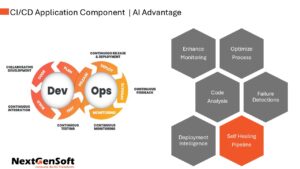Understanding and Measuring DevOps Maturity: How NextGenSoft Can Help
The DevOps Maturity Model serves as an organized system that empowers organizations to assess their DevOps practices across groups, devices, forms, and cultures. By looking over the current state, it recognizes crevices and follows critical steps to improve capability, collaboration, and mechanization in software delivery.
A DevOps maturity assessment is imperative to understanding an organization’s current capabilities and pinpointing zones for progression. It alters improvement and operations bunches, optimizes forms, and ensures the choice of viable apparatuses. This results in speedier time-to-market, superior quality, and enhanced customer satisfaction. Businesses can use a roadmap for persistent change, driving maintained victory in competitive markets.
NextGenSoft specializes in DevOps health checks for startups USA and custom-made arrangements for DevOps gap analysis services USA. Our DevOps consultants are proficient in planning development, toolchain integration, defining and identifying improvement needs, and detecting DevOps bottlenecks USA. By working with NextGenSoft, you may automate DevOps operations in the USA, make progress on your software delivery cycle, engage in dependable cooperation, and energize your path to better development. reach out and Contact Us to learn more.

Stages of the DevOps Maturity Model

Initial/Ad-Hoc
Characteristics:
– Processes are unstructured and manual.
– Development and operations teams work in silos.
– Minimal automation and a lack of standardized workflows.
– Reactive problem-solving rather than proactive prevention
Focus on :
– Building awareness and understanding of DevOps principles.
– Identifying and addressing immediate pain points.
Defined/Managed
Characteristics:
– Some automation of routine tasks.
– Some processes are documented and repeatable.
– Teams begin to collaborate, but tool integration is minimal.
– Early adoption of version control and continuous integration practices.
Focus on :
– Establishing clear processes and workflows.
– Implementing basic automation tools.
– Improving communication and collaboration channels.
Standardized/Integrated
Characteristics:
– Processes are standardized and toolchains are integrated.
– Automation is applied to key workflows, including testing and deployment.
– Teams collaborate effectively with shared goals and responsibilities..
Focus on :
– Expanding automation capabilities.
– Implementing robust monitoring and logging.
Optimized/Measured
Characteristics:
– Data-driven decision-making based on key performance indicators (KPIs).
– Continuous improvement through feedback loops and retrospectives.
– High levels of automation and self-service capabilities.
Focus on :
– Establishing a culture of continuous improvement.
– Analyzing data to identify areas for optimization.
– Implementing predictive analytics and proactive risk management.
Advanced/Innovative
Characteristics:
– A culture of innovation and experimentation.
– High levels of automation and self-service capabilities.
– Proactive and predictive capabilities
– Continuous learning and adaptation.
Focus on :
– Embracing new technologies and practices.
– Fostering a culture of innovation and experimentation.
– Continuously optimizing processes and improving performance.
How to Assess Your DevOps Maturity ?
Define Key Assessment Areas
- At first, it is essential to align and collaborate between dev, ops, and other teams.
- Checkout for standardizations, repetition of activities, and workflows.
- For CI/CD, logging, monitoring, and more, examine the adoption of DevOps tools.
- Check whether the performance is measured, tracked, and acted upon.
- Comply with standard regulations and evaluation of the integration of DevSecOps.
Choose a Suitable Assessment Framework
Internal Assessment
- Develop a customized checklist or survey based on your particular needs and destinations.
Consider employing a SWOT analysis (Strengths, Weaknesses, Opportunities, Threats) to recognize key regions for change.
External Assessment
- Lock in a third-party expert or utilize a pre-built assessment instrument.
Industry Benchmarks
- Utilize systems just like the DevOps Research and Assessment (DORA) measurements or the Capability Maturity Model Integration (CMMI) to compare your performance against industry measures.
Gather Data and Information
Collect quantitative data:
- Mean time to recovery (MTTR), lead time for changes, deployment frequency, change failure rate, etc. are some of the collective quantitative data.
Gather qualitative data:
- To gather quantitative data organizations shall conduct interviews with team members, review feedback from stakeholders and customers, observe team interactions, analyze project documentation, and more.
Identify and Analyze Gaps
- After finalizing your chosen benchmarks and frameworks, organizations shall identify and compare discrepancies.
- Further, it is essential to identify weaknesses and strengths in real-time DevOps practices.
- Based on the data-driven analysis, prioritize the areas of improvement and streamline workflows.
Create a DevOps Maturity Score
- From “Initial” to “Advanced”, it is foremost essential to develop a scoring mechanism that evaluates each area by quantifying maturity levels.
Create an Action Plan
- Create a guide for change based on your discoveries.
- Set particular, quantifiable, achievable, relevant, and time-bound (Smart) objectives.
- Assign obligations and timelines for actualizing improvements.
Monitor and Continuously Improve
- Track every step and approach regularly towards achieving the goals.
- Monitor your DevOps maturity assessment level by conducting periodic assessments.
- Continuously refine your DevOps practices based on feedback and new insights.
Common Pitfalls in DevOps Maturity Progression
Resistance to Change
Silos are created by cultural inertia and transformation is slowed down, in addition to resistance to implementing new techniques. Promoting transparency, offering training to facilitate transitions, and conveying advantages to facilitate transitions shall be promoted by organizations.
Over-reliance on Tools without Process Alignment
Essentially focusing on tools whereas overlooking streamlining of workflows results in inefficiency and poor ROI. Organizations should prioritize streamlining workflows and improving tools with strategies for improved DevOps maturity assessment.
Neglecting the Cultural Aspect
In places where collaboration and accountability are overlooked, team splits and collaborations are weakened. For successful DevOps gay analysis services, organization silos shall be dismantled and cross-functional communication shall be established.
Inadequate Automation
Major errors, deployment issues, testing bugs, and more occur when the processes are traditional or partially automated. Organizations must fully automate their several processes to reduce delivery time and achieve overall efficiency.
Ignoring Security and Compliance (DevSecOps)
Failing to coordinate security leads to vulnerabilities and compliance risks. Organizations ought to implant security into DevOps through automated filters, compliance checks, and proactive cyber threat relief.
Lack of Metrics and Monitoring
MTTR and deployment frequency are some of the topmost data required for monitoring progress and optimizing DevOps processes. For making well-informed decisions and monitoring the overall processes, organizations shall implement data-driven monitoring.
Poorly Defined Roles and Responsibilities
Wherever the roles and responsibilities are not defined, it becomes utmost difficult to streamline workflows as they turn out to be delayed, inefficient, and perplexing. Hence, organizations shall ensure to clearly define the roles, and accountabilities, and ensure that everyone is aware of their duties, in order to handle this.
Failure to Iterate and Improve Continuously
Maturity levels stagnate and the failure to adjust to changing trade needs results from a disappointment to persistently iterate and improve. Organizations must embrace a persistent enhancement mentality through visit updates, reviews, and feedback in order to address this.
Unrealistic Expectations and Over-Commitment
There are chances of frustration, lack of desired progress, and burnout if unrealistic expectations and over-commitment fail. It becomes crucial for organizations to address such issues by setting incremental improvements, realistic goals, and celebrating major as well as small successes.
Why NextGenSoft?
End-to-End Expertise
Partner with NextGenSoft, a global digital transformation company, and leverage our multi-cloud engineers’ abilities. As a trusted IT solutions provider, we build up secure inter-cloud networks, map native cloud services, and make vendor-agnostic methodologies to maximize esteem and minimize dangers.
Delivery Excellence
We rethink conveyance fabulousness with optimized program lifecycles. From advancement to arrangement, our digital transformation services and solutions focus on dependable, high-quality discharges that enhance client satisfaction.
Flexible Hiring Model
NextGenSoft’s adaptable contracting models give access to talented IT service providers custom-fitted to your needs. Scale easily with agile assets for DevOps, guaranteeing consistent collaboration and venture victory.
Transparent Actions
Our commitment to straightforwardness builds belief and cultivates cooperation. As a leading digital transformation company in India, we guarantee adjusted objectives, open communication, and compelling collaboration for shared success.
DevOps Maturity Model Implementation Strategy

Assess Current Maturity Level
DevOps maturity assessment begins with defining clear objectives, this includes trackable factors like improved code quality practices and faster time-to-market.
Develop a Custom Roadmap
Assess current forms, including distinguishing bottlenecks, manual steps, and regions for improvement, while gathering team input and analyzing existing tools.
Implement Processes and Tools
DevOps health check for startups and giant industries can deliver ultimate results, if tool selection is considered based on the team's skill set, scalability, integration capabilities, budget, etc.
Monitor Progress and Metrics
Make a visual representation of the pipeline, characterizing stages (build, test, deploy) and their conditions. Implement extensive automation and conduct a pilot run to validate the DevOps operations.
Monitor & Improve
To maximize efficiency and drive quantifiable results, prioritize optimization of the DevOps operations and monitor the overall core activities.
Enhance Assessment with Our DevOps Expertise

CI/CD Services
Automate software delivery with streamlined CI/CD pipelines, enabling faster releases, improved quality, and reduced manual effort.

Cloud DevOps Services
With DevOps, you can implement automation into deployments and infrastructure optimization, as well as, ensuring a high level of availability with AWS, Azure, and GCP.

Containerization Services
Effortlessly deploy, managed, and scale your microservices with Kubernetes, Docker, and container orchestration.

DevSecOps Services
Automatically manage compliance with CI/CD pipelines, vulnerability management, and mitigate threats to ensure security is built in.
FAQs
-
What is DevOps maturity assessment?
A DevOps maturity assessment USA assesses an organization's DevOps processes, machines, and rehearses to identify attributes and zones for progress. It improves joint efforts, streamlines automation, and streamlines DevOps work processes, and assists organizations with accomplishing operational fabulousness. For new companies in the USA, a DevOps health check for startups guarantees alignment with cutting-edge best practices. -
What are the 4 pillars of data maturity assessment?
The 4 pillars of data maturity assessment include data governance, data quality, data analytics, and data culture. These components ensure effective data management and decision-making for modern organizations. -
How do you conduct a maturity assessment?
The process of analyzing current workflows, identifying DevOps bottlenecks USA, and comparing against industry benchmarks is known as a maturity assessment. The approach includes gap analysis, tailored recommendations, and action plans. DevOps maturity assessment USA and DevOps health check for startups USA: Startups can utilize NextGenSoft - One of the best DevOps consulting company to determine bottlenecks via DevOps maturity assessment USA & DevOps health check for startups USA and enhance efficiency. These can help companies evolve operations as strong DevOps frameworks. -
How to Perform DevOps Health Checks?
DevOps health checks analyze workflows, tool efficiency, and team collaboration to identify and resolve bottlenecks. For new businesses, this ensures optimized pipelines. NextGenSoft specializes in DevOps health checks for new businesses in the USA. -
What are the different types of bottleneck operations in DevOps?
Common DevOps bottlenecks include manual workflows, moderate CI/CD pipelines, asset constraints, and lack of automation. It is crucial to identify DevOps bottlenecks in the USA to ensure smoother operations and faster deployments. -
What is DevOps optimization?
DevOps optimization focuses on streamlining processes, improving tool integrations, and automating workflows to achieve faster delivery, improved collaboration, and diminished operational costs. -
What is the gap in DevOps?
DevOps gaps are inefficiencies in workflows, tools, or group collaboration that prevent efficiency. Conducting a gap analysis helps bridge these gaps for consistent DevOps development and optimization.
Contact us

Submit Your Inquiry

Detailed Proposal

Collaborate and Plan



